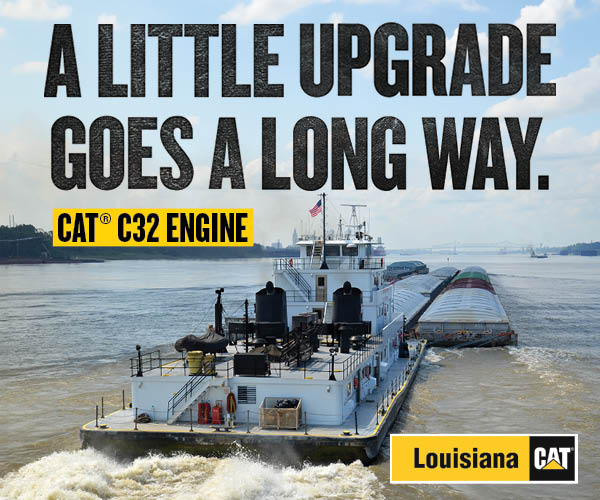Beyond The ‘Maritime Moment’ With Jennifer Carpenter
Jennifer Carpenter is uniquely positioned to participate in and interpret recent conversations about how best to support and revitalize the U.S. merchant marine and domestic shipbuilding capabilities. She joined the American Waterways Operators, which represents tug, towboat and barge operators, shortly after the Exxon Valdez oil spill dominated headlines and led to the passage of the Oil Pollution Act of 1990. That act brought many changes to both the blue- and brown-water maritime worlds.
Carpenter became president and CEO of the AWO in January 2020, and in 2024 added an additional responsibility, becoming president of the American Maritime Partnership, which advocates for the entire Jones Act fleet — both blue- and brown-water — and American shipyards and mariners. Her “two hats” give her a unique window onto maritime issues.
Waterways Journal: This is a moment of attention to maritime issues that is perhaps unprecedented in 50 years. What are the implications of this national conversation for brown-water operators specifically?
Jennifer Carpenter: I am really hopeful! There’s a strong bipartisan recognition that the maritime sector is essential to our national security and economic prosperity. Our task as maritime advocates is to make sure this is not just a “maritime moment,” but that the focus extends into the future, to sustain the efforts that will be needed.
Much of the current conversation is focused on restoring international shipping and blue-water capacity, because that’s where we have a big deficit. Thanks to the Jones Act and the investments that AWO and AMP members have made, we have the fleet we need to move U.S. domestic commerce within our own borders – on the rivers, on the coasts and in the noncontiguous trades. We need to build on that strong foundation and increase the ability of the U.S. merchant fleet to support U.S. interests around the globe.
The task may seem daunting, especially given the comparisons we have been seeing about Chinese shipbuilding capacity, but our job is not to match what the Chinese are doing. We don’t need to have 75 percent of the world’s shipbuilding order book. We need to increase the number of vessels flying the U.S. flag and build up the capacity of U.S. shipyards. We need the industrial base, and the worker populations, to support that.
I believe the rising tide of interest in supporting the U.S. maritime industry will lift all boats — including ours. At the same time, we need to make sure a well-intentioned effort to grow the number of U.S. vessels in international trade doesn’t have unintended negative consequences on the domestic trade. For example, a deep-sea vessel that gets a subsidy to be part of the proposed Strategic Commercial Fleet can’t be allowed to enter the domestic trade and compete against unsubsidized vessels currently serving those trades. That’s not the intent, and we need to make sure it stays that way.
I think one of the most important things the president’s maritime executive order does is set a clear goal. Section 2 of that order says: “It is the policy of the United States to revitalize and rebuild domestic maritime industries and workforce to promote national security and economic prosperity.” Clearly articulating where we want to go is the first step on the road to getting there.
WJ: Any thoughts on the current discussion around the suggestion of replacing the Small Shipyard Program by a larger grant program?
JC: The Small Shipyard grant program, administered by the Maritime Administration, is a small program, but it has provided a big bang for the buck, and it’s been consistently supported across all administrations since its inception. There have been brown-water shipyards included in every grant cycle. Over the years, those “small” grants have resulted in significant upgrades. Whether that program is maintained (with additional resources) or evolves into a larger program, we shouldn’t lose the ability to focus on all tiers of the shipyard industrial base in this country.
WJ: There is a separate series of maritime recommendations under debate in Washington, coming from the Office of the U.S. Trade Representative, including proposed fees for operators using Chinese-built vessels. Casual news consumers may not realize that the USTR actions began in the last administration and are separate from the measures in the SHIPS for America Act and the president’s maritime executive order.
JC: Yes, and there’s been a lot of work to try to avoid negative impacts from the well-intentioned bipartisan effort to push back on China’s unfair practices and incentivize the use of U.S. flag vessels. But I really want to highlight the importance of an enduring bipartisan policy consensus to prioritize maritime and avoid “flip-flop” from one administration to the next, because that will send the demand signal to encourage investment. We want to give credit where credit is due, to President Trump, to the bipartisan team of legislators behind the SHIPS for America Act – Sen. Mark Kelly, Sen. Todd Young, Rep. John Garamendi, Rep. Trent Kelly – and all those who have prioritized revitalizing the merchant marine. We need to keep that going!
WJ: How disappointed was AWO that the U.S. Senate didn’t address California’s Commercial Harbor Craft Rule imposed by the California Air Resources board on May 22 when it used the Congressional Review Act to revoke some of EPA’s authorizing waivers under the Clean Air Act to address auto and truck emissions and EV mandates?
JC: AWO is engaged in litigation to challenge EPA’s partial approval of the CHC rule, which we believe was wrongly decided.
We need uniform national standards for marine engines, and we need a predictable regulatory structure with ambitious but pragmatic requirements that businesses can plan and invest to meet. We don’t have that when one state can set its own standards with requirements that aren’t achievable or safe.
Big picture, the idea that we should have to choose between trade and a clean environment is a false choice. We can have both! Just look at the Oil Pollution Act of 1990, which established an ambitious goal: the replacement of single-hull tank vessels with double hulls. But it established a phase-out schedule that allowed vessel owners to plan and invest in new equipment while allowing existing equipment to serve out its economic life. Commerce continued to move, single hulls were phased out, and oil pollution from tank vessels declined dramatically.
We can do the same thing with harbor craft emissions. Our industry wants to reduce them! But we need to be able to do it within a reasonable timeline, in a structured way, using technology that is commercially available and safe. EPA recognized this when it established the marine engine tier requirements. Existing vessels could be upgraded through Tier 3, but Tier 4 requirements only applied to new vessels built after a certain date because they couldn’t practically be retrofitted on existing vessels. It was a pragmatic way to go, and it worked.



